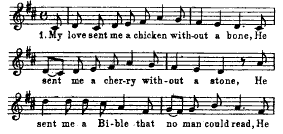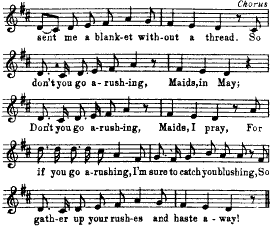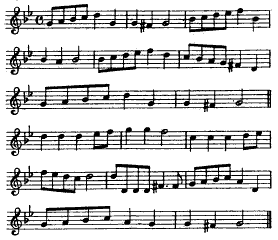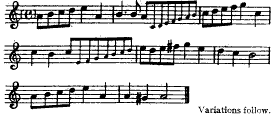'Under the Spreading Chestnut Tree' The Adventures of a Tune- Gilchrist 1940
'Under the Spreading Chestnut Tree': The Adventures of a Tune
by Anne G. Gilchrist
The Musical Times, Vol. 81, No. 1165 (Mar., 1940), pp. 112-113
'Under the Spreading Chestnut Tree' The Adventures of a Tune
By ANNE G. GILCHRIST
As there has been a good deal of discussion about the origin of 'The Spreading Chestnut Tree' - particularly as to whether the tune is correctly described by Weinberger as an Old English Air-the following notes may be useful in helping to settle the question.
I heard 'The Chestnut Tree' for the first time in the broadcast from the Beecham Sunday Concert on December 17 last as the theme of Weinberger's Variations for Orchestra, and at once recognized it as a version of an old English tune called 'Go no more a-rushing,' which was arranged for virginals by William Byrd and also Giles Farnaby-by the latter under the title of 'Tell mee, Daphne.' It may therefore be of interest to state what I have now discovered of its origin and history.
The version nearest 'The Chestnut Tree' tune is printed in Miss M. H. Mason's 'Nursery Rhymes and Country Songs,' published by Metzler in 1877. All the songs and tunes in this now scarce book were, its compiler says, derived from oral tradition (I have found no evidence to the contrary) and mostly learnt from her grandmother, Mrs. Mitford. This traditional major version of 'Go no more a-rushing' is printed below. [Tune 2.]
Its relation to the 'Chestnut Tree' of Mr. R. Sterndale Bennett's printed version and Weinberger's Variations is obvious, and hardly less so is its relation to the earlier' Go no more a-rushing' - which is also the tune of 'Tell me, tell me, Daphne.' Here are the four tunes :
Under the Spreading Chestnut Tree
Weinberger and also R. Sterndale Bennett's published copy. [Boosey & Hawkes]

_______________________________________________
A Paradox (Go no more a-rushing)
Miss Mason's Nursery Rhymes and Country Songs, 1877.
Ex. 2


1. My love sent me a chicken with-out a bone,
He sent me a cher-ry with-out a stone,
He sent me a Bi-ble that no man could read,
He sent me a blank-et with-out a thread.
Chorus: So don't you go a-rushing, Maids, in May;
Don't you go a-rush-ing, Maids, I pray,
For if you go a-rushing, I'm sure to catch you blushing,
So gather up your rushes and haste away!
___________________________________________
Go no more a-rushing [set by Byrd]
Chappeli's Pop. Music, 1, 158.
['Tell me, tell me, Daphne, where away?' See verse.]
Ex. 3

_________________________
Tell me, Daphne [set by Giles Farnaby].
Fitzwilliam Virginal Book, No. CCLXXX.
Ex. 4

The tune as known to Byrd and Farnaby is in the minor mode, modulating (as we should now say) to its relative major in its second phrase. In Miss Mason's traditional major version the first phrase repeats, perhaps from a difficulty in pitching the second, the ' relative major' having now been lost. In 'The Chestnut Tree' the second, phrase is certainly a late alteration-possibly for harmonic reasons. It is probably this modern phrase (sung to 'When I held you on my knee ') which has condemned the tune as a modern composition in the ears of some musical critics.
The old tune seems to have been popular in the late part of the sixteenth century. Byrd's virginals copy was taken by Chappell from a Byrd MS. in Dr. Rimbault's collection (see. 'Popular Music of the Olden Time,' Vol. I, p. 158, 'Go no more a-rushing '). 'Tell me, Daphne,' with vatiations by Giles Farnaby, is No. CCLXXX in Fuller Maitland's and W. B. Squire's transcript of the ' Fitzwilliam Virginal Book.'
Farnaby's version is very like Byrd's, but consists, like the traditional versions, of the first eight bars only. The pieces in the Fitzwilliam (formerly dubbed ' Queen Elizabeth's ') Virginal Book range from c. 1550 to c. 1620 (see Grove's ' Dictionary' under Virginal Music). 'Tell me, Daphne' is a title in Gordon of Straloch's Lute Book, c. 1623 (now lost); and through the kindness of Mr. Harry Willsher, librarian of Dundee University College, who has been working on the seventeenth-century MSS. discovered in 1935 at Panmure House, Carnoustie (Angus), I have now recovered an early Scots copy of the text (there attached to the tune) of this lost song. The first verse (of five), here given, fits Byrd's copy of the tune (as printed by Chappell under the title ' Go no more a-rushing '), allowing for the Scots transcriber having perhaps 'improved' his copy by writing 'It is' for' 'Tis,' I pray thee' for- 'Prythee,' and inserting 'that' after 'Coridon,' so throwing the lines out of metre:
Panmure MS. [1622-]
Tel me, tel me Daphne, quhair avay [where]
it is [? 'tis] thy Coridon that intreats the to stay
it is [? 'tis] thy Coridon that hes lovit the so long
I pray the, pray the, Daphne, do no wrong.
She is gone benethe yon roks
for to feid hir tender floks
Daphne knows not howe to love
I pray the Coridon thy sut remove [suit]
'Go no more a-rushing, maids, in May' may be the earlier song, as it runs more easily to the quavers. John Fletcher's song 'Tell me, dearest, what is love?' may have been written to the same tune ('Tell me, Daphne'), repeating the last three verse lines. Fletcher introduces ' Tell me, dearest' into the 'Knight of the Golden Pestle' (first produced 1610-11). The only text I have discovered for 'Go no more a-rushing' is Miss Mason's traditional verse, which forms a wholly irrelevant chorus to the Paradox song (to the same tune)
'My love sent me a chicken without a bone-'
This-really is a folk-song, and the 'Go no more a-rushing ' chorus has apparently adhered to the tune when it was borrowed for (or at any rate sung to) the Paradox song, of which Miss Mason prints another version, and of which early forms are also known, some with a mock-Latin refrain. Miss Mason's traditional copy of the tune and the 'Go no more a-rushing' words form the link between the old English and the modern form.
So 'Under the Spreading Chestnut Tree' is really an Old English --perhaps originally a dance-tune, preserved traditionally and lately modernized. How and when it came into the possession of Boy Scouts is still obscure, and its latest phase, as a successor to the Lambeth Walk, may here be ignored.
As for the gestures of the Community Song, they also have an ancestry.
1. About fifty years ago, Tom Dale, a member of the Minnehaha Minstrels, a talented amateur troupe in Manchester, who raised thousands of pounds for charities by their entertainments, invented a comic turn-a dramatic recital of ' The Village Blacksmith' in the character of a man with a wooden arm-the fun beginning when the arm would not work and had to be knocked or screwed into the proper position for the appro- priate gesture, before the reciter could proceed.
The first gesture- 'spreading' - was a 'comprehensive wave of the hand and arm in a semi- circle over the head.' I remember also the dogged propulsion of the hand and arm upwards to induce them to point to ' Paradise,' and their equal dis- inclination to point downwards to 'her grave'! The wooden arm 'stunt' afterwards spread in connection with other poems.
2. The dropping of a word at the end of a line was the feature of a game-song at children's parties about the same period. To the tune of 'John Brown's Body,' the line 'The Emperor Napoleon had twenty thousand men' (thrice), with the chorus 'As we go marching along,' the last word in successive verses was replaced by a nod, until in the end there was nothing left but a succession of nods and the chorus- the penultimate 'The. . . ' being the most absurd of all!